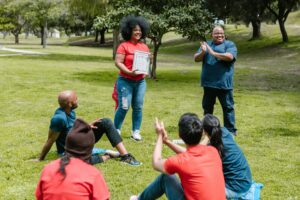What does BICS and CALP mean?
BICS and CALP are acronyms. They describe children’s conversational skills versus grade-appropriate academic proficiency in a new language.
BICS stands for Basic Interpersonal Communication Skills
CALP stands for Cognitive Academic Language Proficiency
Consider how long it takes an immigrant student to achieve bilingual competency. Well, there are two kinds of language proficiency: social and academic.
Kids quickly learn how to communicate fluently with other kids on the playground.
How long does BICS take?
Within a few months, a foreign student might chat confidently and fluently with their friends.
That is because the language used in social interactions is full of context. Social conversations are meaningful, cognitively undemanding, and non-specialized.

But this does not mean the student is actually fluent!
It is important for educators to realize that conversational fluency does not mean the student won’t still struggle with test instructions or with specialized terminology.
How long does CALP take?
The acronyms BICS and CALP refer to the length of time required by immigrant children to develop conversational skills in the target language and grade-appropriate academic proficiency in that language
According to Cummins’s and Collier’s evidence, it takes 5-7 years for K-12 students to acquire CALP in the second language. That’s a long time! And, that is only if the learner already has literacy in their native language.
If the student can’t read or write in their native language, a student might need 7–10 years to acquire CALP in the target language.
That means an immigrant student who seems fluent in English in an American classroom, for example, might still struggle with specific academic terms years after a teacher might not think of them as an ELL (an English language learner).
James Cummins is an important ELL or ESL language theorist also known for Second Language Acquisition. He is known for another common ESL acronym: CULP or Common Underlying Language Proficiency.

James Cummins
Cummins advocated for the existence of a CUP. The term common underlying proficiency (CUP)has also been used to refer to the cognitive/academic proficiency that underlies academic performance in both languages.
Cummins believed that the linguistic and academic benefits of additive bilingualism for individual students provide an additional reason to support students in maintaining their First language (LI) while acquiring English. Maintaining their LI (first language) helps students remain connected to their community, culture, and family. In addition, maintaining their LI, according to Cummins, helps them learn L2.
To learn more, visit this bilingual site for educators and families of English language learners.
Also, you might be interested in these posts.






